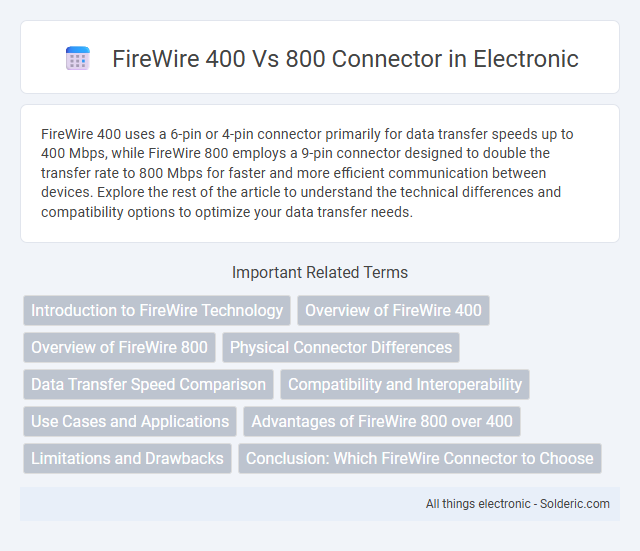FireWire 400 uses a 6-pin or 4-pin connector primarily for data transfer speeds up to 400 Mbps, while FireWire 800 employs a 9-pin connector designed to double the transfer rate to 800 Mbps for faster and more efficient communication between devices. Explore the rest of the article to understand the technical differences and compatibility options to optimize your data transfer needs.
Comparison Table
| Feature | FireWire 400 (IEEE 1394a) | FireWire 800 (IEEE 1394b) |
|---|---|---|
| Data Transfer Rate | Up to 400 Mbps | Up to 800 Mbps |
| Connector Type | 6-pin or 4-pin | 9-pin |
| Cable Length | Up to 4.5 meters | Up to 100 meters (with optical cables) |
| Power Delivery | Up to 15V, 1.5A | Up to 8 to 30V, higher current support |
| Compatibility | Compatible with IEEE 1394a devices | Backward compatible with FireWire 400 devices |
| Use Cases | Standard video cameras, external drives | High-speed data transfer, professional video equipment |
Introduction to FireWire Technology
FireWire technology, originally developed by Apple, enables high-speed data transfer between digital devices with minimal latency, supporting real-time audio and video streaming. FireWire 400 offers transfer rates up to 400 Mbps, while FireWire 800 doubles that speed to 800 Mbps through an updated connector design. Understanding the differences between FireWire 400 and 800 connectors helps you optimize your setup for faster data workflows and improved device compatibility.
Overview of FireWire 400
FireWire 400, also known as IEEE 1394a, supports data transfer rates up to 400 Mbps and primarily uses a 6-pin connector designed for both power and data transmission. This interface was widely adopted for connecting digital video cameras, external hard drives, and other peripherals due to its reliable, high-speed point-to-point connection. Despite being slower than FireWire 800's 800 Mbps throughput and using a different 9-pin connector, FireWire 400 remains compatible with many legacy devices through adapter cables.
Overview of FireWire 800
FireWire 800, also known as IEEE 1394b, offers data transfer speeds up to 800 Mbps, doubling the bandwidth of FireWire 400. It features a 9-pin connector designed for enhanced reliability and supports longer cable lengths up to 100 meters with optical cables. This interface is commonly used in professional video and audio equipment, providing faster and more stable connections compared to its predecessor.
Physical Connector Differences
FireWire 400 uses a 6-pin or 4-pin connector, with the 6-pin version providing power and data transfer, while the 4-pin version supports data only. FireWire 800 employs a distinct 9-pin connector designed for faster data transfer rates and improved performance. The FireWire 800 connector features a rectangular shape with beveled edges, making it physically incompatible with FireWire 400 ports without an adapter.
Data Transfer Speed Comparison
FireWire 400 supports a maximum data transfer rate of 400 Mbps, making it suitable for standard video and audio device connectivity. In contrast, FireWire 800 doubles the speed to 800 Mbps, providing enhanced performance for high-definition video editing and faster file transfers. This speed increase significantly reduces data transmission time, making FireWire 800 the preferred choice for professional multimedia applications.
Compatibility and Interoperability
FireWire 400 and FireWire 800 connectors differ in data transfer speeds and physical design, with FireWire 400 using a 6-pin or 4-pin connector and FireWire 800 using a 9-pin connector. FireWire 800 ports support backward compatibility with FireWire 400 devices through appropriate cables or adapters, allowing interoperability between the two standards despite their physical differences. Your setup can maintain compatibility by ensuring devices and cables are designed to bridge the FireWire 400 and FireWire 800 interfaces.
Use Cases and Applications
FireWire 400 offers optimal performance for basic audio and video transfers, making it ideal for connecting older camcorders and external hard drives in consumer-grade setups. FireWire 800 supports higher data transfer rates up to 800 Mbps, suited for professional audio/video editing, storage solutions, and high-speed device chaining. Your choice between these connectors depends on the required speed and compatibility with legacy or modern equipment.
Advantages of FireWire 800 over 400
FireWire 800 offers a significant speed advantage with data transfer rates up to 800 Mbps compared to FireWire 400's 400 Mbps, enabling faster file transfers and improved performance for video editing and large data backups. Its improved cable design supports longer cable lengths up to 100 meters with active cables, providing greater flexibility in device placement. FireWire 800 also delivers enhanced power output, enabling it to better support bus-powered devices without external power sources.
Limitations and Drawbacks
FireWire 400 supports a maximum data transfer rate of 400 Mbps, which limits its performance for high-bandwidth applications compared to FireWire 800's 800 Mbps speed. FireWire 400 uses a 6-pin connector that lacks power delivery capabilities, restricting its use with devices requiring external power. The FireWire 800 connector, though faster, has compatibility constraints with older FireWire 400 devices, often necessitating special cables or adapters that can introduce signal degradation or connection instability.
Conclusion: Which FireWire Connector to Choose
Choosing between FireWire 400 and 800 connectors depends on your data transfer speed requirements and device compatibility. FireWire 800 offers faster transfer rates up to 800 Mbps, ideal for high-bandwidth tasks like video editing, while FireWire 400 supports speeds up to 400 Mbps, suitable for general use and older devices. Your choice should prioritize FireWire 800 for optimal performance unless your equipment exclusively supports FireWire 400.
FireWire 400 vs 800 connector Infographic

 solderic.com
solderic.com